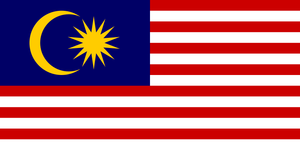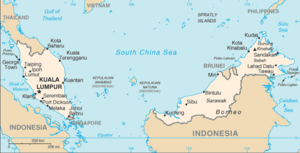Malaysia: Difference between revisions
No edit summary |
Candace Goh (talk | contribs) No edit summary |
||
| (14 intermediate revisions by 3 users not shown) | |||
| Line 6: | Line 6: | ||
'''Original Editor '''- Jetro Tenerife | '''Original Editor '''- Jetro Tenerife | ||
''' | '''Top Contributors''' - {{Special:Contributors/{{FULLPAGENAME}}}} | ||
</div> | </div> | ||
== < | == Introduction<ref>Central Intelligence Agency. "Malaysia." ''[https://www.cia.gov./the-world-factbook/countries WorldFactbook].'' Last updated 31 March 2021. Last accessed 31 November 2021.</ref> == | ||
[[File:Flag of Malaysia.png|left|frameless|Malaysian flag]] | |||
[[File:Malaysia map.png|frameless]] | |||
* '''Continent''': Southeast Asia | |||
* '''Population''': 32.6 million people (2020) | |||
* '''Capital''': Kuala Lumpur with about 8 million inhabitants; administrative capital: Putrajaya with less than 100,000 inhabitants | |||
* '''Language''': Malay/Bahasa Malaysia (official) | |||
* '''Religion''': Muslim (official) 61.3%, Buddhist 19.8%, Christian 9.2%, Hindu 6.3%, Confucianism, Taoism, other traditional Chinese religions 1.3%, other 0.4%, none 0.8%, unspecified 1% (2010 est.) | |||
* '''Ethnicity''': Bumiputera 62% (Malays and indigenous peoples, including Orang Asli, Dayak, Anak Negeri), Chinese 20.6%, Indian 6.2%, other 0.9%, non-citizens 10.3% (2017 est.) | |||
* '''Literacy''': 93% of the population 15 years and above can read or write | |||
* '''Currency''': Ringgit Malaysia (RM) | |||
== | == Access/Entry Point to Physiotherapy Services == | ||
== | There is no direct access to physiotherapy services in Malaysia. Meaning that, individuals cannot refer themselves to a physiotherapist without referral from another healthcare professional. A doctor's referral is needed for an individual to receive physiotherapy treatment. In the urban setting, patients/clients would be visiting hospitals and doctor’s office to get access to physiotherapy services. In rural settings, there is a two-tier system of community clinics and health clinics. For medical care, patients go to community clinics first and, if more assistance is needed, then they are referred to health clinics. The community clinics are managed by community nurse, while a health management officer or family medicine specialist is in-charge in health clinics. The physician from the health clinic can then refer patients to therapy<ref name=":0">Ariff KM, Lieng TC. Rural Health Care in Malaysia. Aus J Rural Health. 2002; 10, 99-103</ref>. People living in the rural areas also tend to go to traditional healers for musculoskeletal conditions<ref name=":0" />. <br> | ||
The | == Regulation == | ||
Physiotherapists are included in the Allied Health Profession Act 774, 14 February 2016, and need to be registered with the [http://mimls.org/ahp_act/ Malaysian Allied Health Professions Council]. The AHP ACT is estimated to be in force in 2021 with Physiotherapists in the country registering to the database in 2021. Once this is done all physiotherapists will be given an Annual Practicing Certificate and are only allowed to practice PT with this certification. The Ministry of Health will then by then obtain a full database of the number of physiotherapists in the country and legislation may start in earnest for the profession. | |||
== | == Physiotherapy Professional Entry Level Education == | ||
* | ==== Undergraduate - Bachelor Degree ==== | ||
* [https://study.utar.edu.my/physiotherapy.php Universiti Tunku Abdul Rahman (UTAR)] | |||
* [https://newinti.edu.my/programme/bsc-hons-physiotherapy/ INTI International University and Colleges] | |||
* [https://mahsa.edu.my/faculties/Health/bachelor-physiotherapy.php MAHSA University] | |||
* [https://www.uitm.edu.my/index.php/en/ Universiti Teknologi Mara (UiTM)]<br> | |||
==== Postgraduate - Specialisation (Masters/PHD) ==== | |||
* [https://www.uitm.edu.my/index.php/en/ Universiti Teknologi Mara (UiTM)]<br> | |||
== Professional Associations == | == Professional Associations == | ||
The [https://www.mpa.net.my/index.php Malaysian Physiotherapy Association (MPA)] is the professional organisation representing Physiotherapists in Malaysia. It had its inaugural meeting on March 9, 1963 led by Dr. M. K. Rajkumar. The organisation was registered as an Association on August 6, 1963, initially with 12 members. The association is a member of the [https://world.physio/membership/malaysia World Confederation for Physical Therapy (WCPT)] since 1974, and is the founder member of the Asian Confederation of Physical Therapy in 1980. Among MPA’s duties include acting as an advisory body for setting up physiotherapy services in the public and community health centres.<br> | |||
== Information about the Patient Community == | == Information about the Patient Community == | ||
According to the the World Bank statistics for 2008<ref>Rural Population in Malaysia. Trading Economics. Available from: http://www.tradingeconomics.com/malaysia/rural-population-wb-data.html</ref>, 70.4%, or about 1.9 million, of the population in Malaysia are in the urban areas. There are State Hospitals managed by medical officers, paramedics and nurses on each of the the 13 States. As for the rural areas, the Ministry of Health has extensive network of rural health clinics, mobile teams and “the flying doctor service”.<ref name=":0" /> | |||
<br> | |||
== Type of | == Type of Healthcare System == | ||
Malaysia has a universal health care system, with Government and private and sectors. The Government allocates as much as 5% of the its budget to public healthcare. Private hostpitals has recently been growing due to increased number of foreigners in the area<ref>Hague A. Culture-bound syndromes and healing practices in Malaysia. Mental Health, Relegion and Culture. 2008: 11(7), 685-696.</ref>.<br><br> | |||
== Payment System == | == Payment System == | ||
Ariff and Lieng<ref name=":0" /> states that rural health services are subsidised by the Malaysian Government. The patients pay one Malaysian Ringgit (about $ 0.25) for medications. There are several medical and health insurance available to be used on private clinics and hospitals. <br> | |||
== References == | == References == | ||
<references /> | <references /> | ||
Latest revision as of 16:41, 31 March 2021
Welcome to Worldwide Physical Therapy Practice: a focus on Primary Care Physical Therapy
This is a project created by and for the students in the School of Physical Therapy at the University of St. Augustine in St. Augustine Florida. Please do not edit unless you are involved in this project, but please come back in the near future to check out new information!!
Original Editor - Jetro Tenerife
Top Contributors - Jetro Tenerife, Candace Goh, Admin and Elaine Lonnemann
Introduction[1][edit | edit source]
- Continent: Southeast Asia
- Population: 32.6 million people (2020)
- Capital: Kuala Lumpur with about 8 million inhabitants; administrative capital: Putrajaya with less than 100,000 inhabitants
- Language: Malay/Bahasa Malaysia (official)
- Religion: Muslim (official) 61.3%, Buddhist 19.8%, Christian 9.2%, Hindu 6.3%, Confucianism, Taoism, other traditional Chinese religions 1.3%, other 0.4%, none 0.8%, unspecified 1% (2010 est.)
- Ethnicity: Bumiputera 62% (Malays and indigenous peoples, including Orang Asli, Dayak, Anak Negeri), Chinese 20.6%, Indian 6.2%, other 0.9%, non-citizens 10.3% (2017 est.)
- Literacy: 93% of the population 15 years and above can read or write
- Currency: Ringgit Malaysia (RM)
Access/Entry Point to Physiotherapy Services[edit | edit source]
There is no direct access to physiotherapy services in Malaysia. Meaning that, individuals cannot refer themselves to a physiotherapist without referral from another healthcare professional. A doctor's referral is needed for an individual to receive physiotherapy treatment. In the urban setting, patients/clients would be visiting hospitals and doctor’s office to get access to physiotherapy services. In rural settings, there is a two-tier system of community clinics and health clinics. For medical care, patients go to community clinics first and, if more assistance is needed, then they are referred to health clinics. The community clinics are managed by community nurse, while a health management officer or family medicine specialist is in-charge in health clinics. The physician from the health clinic can then refer patients to therapy[2]. People living in the rural areas also tend to go to traditional healers for musculoskeletal conditions[2].
Regulation[edit | edit source]
Physiotherapists are included in the Allied Health Profession Act 774, 14 February 2016, and need to be registered with the Malaysian Allied Health Professions Council. The AHP ACT is estimated to be in force in 2021 with Physiotherapists in the country registering to the database in 2021. Once this is done all physiotherapists will be given an Annual Practicing Certificate and are only allowed to practice PT with this certification. The Ministry of Health will then by then obtain a full database of the number of physiotherapists in the country and legislation may start in earnest for the profession.
Physiotherapy Professional Entry Level Education[edit | edit source]
Undergraduate - Bachelor Degree[edit | edit source]
- Universiti Tunku Abdul Rahman (UTAR)
- INTI International University and Colleges
- MAHSA University
- Universiti Teknologi Mara (UiTM)
Postgraduate - Specialisation (Masters/PHD)[edit | edit source]
Professional Associations[edit | edit source]
The Malaysian Physiotherapy Association (MPA) is the professional organisation representing Physiotherapists in Malaysia. It had its inaugural meeting on March 9, 1963 led by Dr. M. K. Rajkumar. The organisation was registered as an Association on August 6, 1963, initially with 12 members. The association is a member of the World Confederation for Physical Therapy (WCPT) since 1974, and is the founder member of the Asian Confederation of Physical Therapy in 1980. Among MPA’s duties include acting as an advisory body for setting up physiotherapy services in the public and community health centres.
Information about the Patient Community[edit | edit source]
According to the the World Bank statistics for 2008[3], 70.4%, or about 1.9 million, of the population in Malaysia are in the urban areas. There are State Hospitals managed by medical officers, paramedics and nurses on each of the the 13 States. As for the rural areas, the Ministry of Health has extensive network of rural health clinics, mobile teams and “the flying doctor service”.[2]
Type of Healthcare System[edit | edit source]
Malaysia has a universal health care system, with Government and private and sectors. The Government allocates as much as 5% of the its budget to public healthcare. Private hostpitals has recently been growing due to increased number of foreigners in the area[4].
Payment System[edit | edit source]
Ariff and Lieng[2] states that rural health services are subsidised by the Malaysian Government. The patients pay one Malaysian Ringgit (about $ 0.25) for medications. There are several medical and health insurance available to be used on private clinics and hospitals.
References[edit | edit source]
- ↑ Central Intelligence Agency. "Malaysia." WorldFactbook. Last updated 31 March 2021. Last accessed 31 November 2021.
- ↑ 2.0 2.1 2.2 2.3 Ariff KM, Lieng TC. Rural Health Care in Malaysia. Aus J Rural Health. 2002; 10, 99-103
- ↑ Rural Population in Malaysia. Trading Economics. Available from: http://www.tradingeconomics.com/malaysia/rural-population-wb-data.html
- ↑ Hague A. Culture-bound syndromes and healing practices in Malaysia. Mental Health, Relegion and Culture. 2008: 11(7), 685-696.








